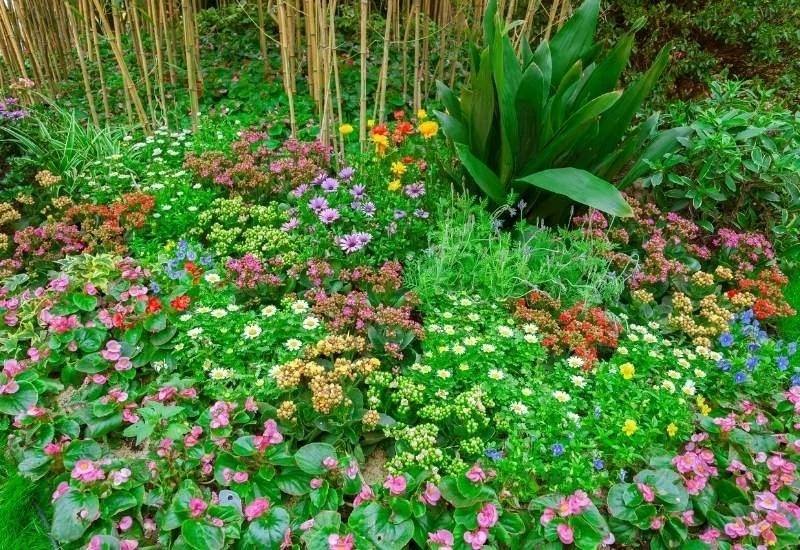
If you’ve been looking to carpet those unsightly patches in your garden that looks bare, barren and forlorn with flowers and lush greenery, ground cover plants that bear evergreen leaves might just be the answer you’re searching for.
Evergreen plants that sprawl, or crawl, across the ground are great for adding year-round appeal, preventing weeds, and avoiding erosion during the winter months when other groundcovers die back and go dormant.
Not only are they forgiving, most are also low-maintenance enough to even walk on. Even better, there are evergreen varieties of groundcovers for almost any need and space, some offers spectacular blooms, some are not, some good for sunny spots others can tolerate shade. There is a hardy variety suited for northern landscapes, while others will thrive in drought.
They can be grouped into: crawling conifers with colored foliage like dwarf junipers and cypresses and succulents like stonecrop, hens and chicks and moss rose, shrubs and finally herbaceous plants.
Even if they are easy to grow, spread rapidly, they do need some attention. So, the most important part of selecting the base of your landscape is considering your growing zone, sun exposure, rainfall and frost.
Since there are so many varieties you can incorporate to your dreary winter landscapes, you will need to narrow down selections based on your conditions. Here are some of our favorite low-maintenance ground cover plants that keep their leaves all year round along with growing information for each one.
18 Amazing Evergreen Ground Cover Plants For Verdant Gardens Year-Round
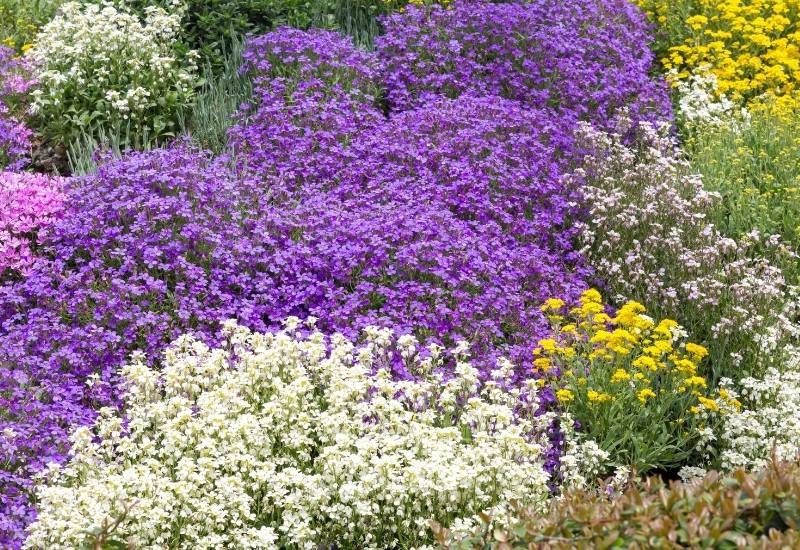
We couldn’t list the hundreds or even thousands of evergreen plants for groundcover, but we chose some of the most popular and made up a list of green friends with different looks, personalities and adaptable to most spaces.
And now, if you are ready, here we go!
Bring color to your backyard bald spots with these 18 ground cover plants that keep their leaves all year.
Succulent Groundcover Plants
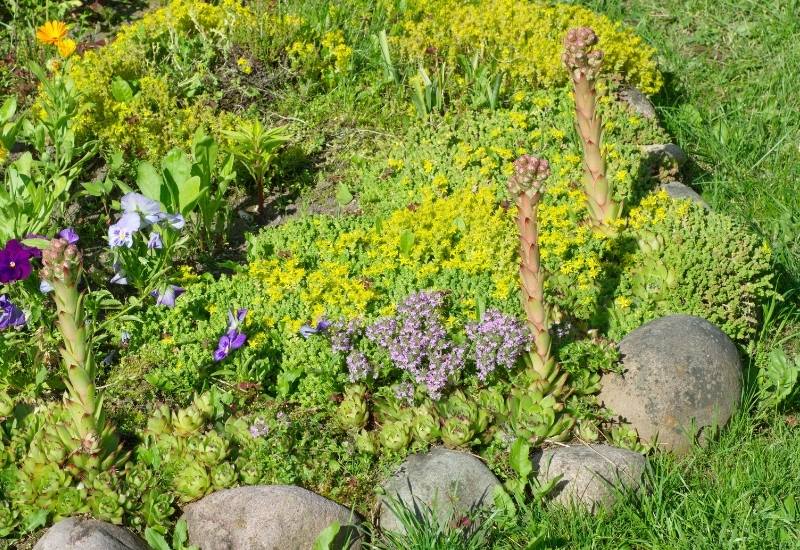
Succulents are excellent evergreens that flower easily, have beautiful, often colored foliage and in most cases resist drought. They are excellent as ground cover especially in xeric gardens (dry gardens).
1: Moss Rose (Portulaca grandiflora)
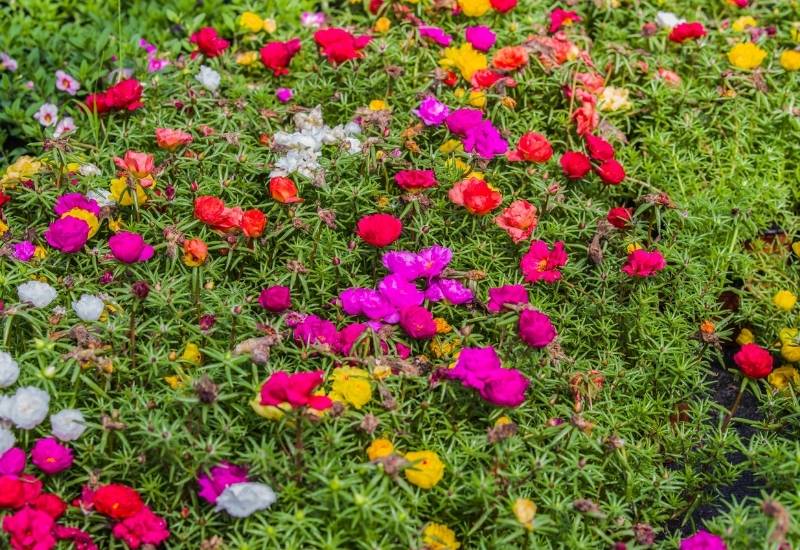
Moss rose, a variety of purslane, is one of may favorite evergreen groundcover plants. It is succulent, and the leaves are quite thick, and they form a permanent blanket of vibrant green for your garden.
But people especially love moss rose for its amazing blooms. The flowers are quite showy, with large petals and there are double varieties too.
The thing is that they are of the brightest hues of white, yellow, pink, magenta, orange or red. You can play with one or two colors or just go wild and have an explosion of colors – from spring to fall! Yes, because this tiny beauty just can’t stop blooming.
2: Elephant’s Ears (Bergenia spp.)
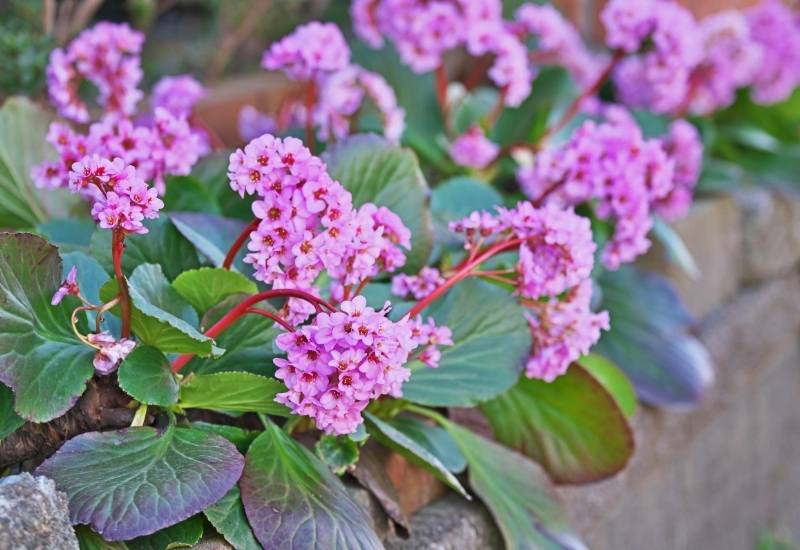
Elephant’s ears is a very popular evergreen plant used as ground cover. Its big, fleshy, usually green and purple leaves do a great job with filling in empty spaces.
It is one of those plants you can forget about, as it needs very little care but keeps embellishing your garden all year round with its hard to miss foliage.
Sometimes, depending on light and climate, it can turn red and even deep purple in color!
But while you may forget about it most times, in spring you really can’t miss it! In fact, it will grab your attention with its beautiful, bright flowers coming on top of red to purple stems.
These are usually pink to magenta, often bright, but some varieties have a more lilac color.
It is also ideal for rock gardens, gravel gardens and low flower beds.
3: Hens and Chicks (Sempervivum spp.)
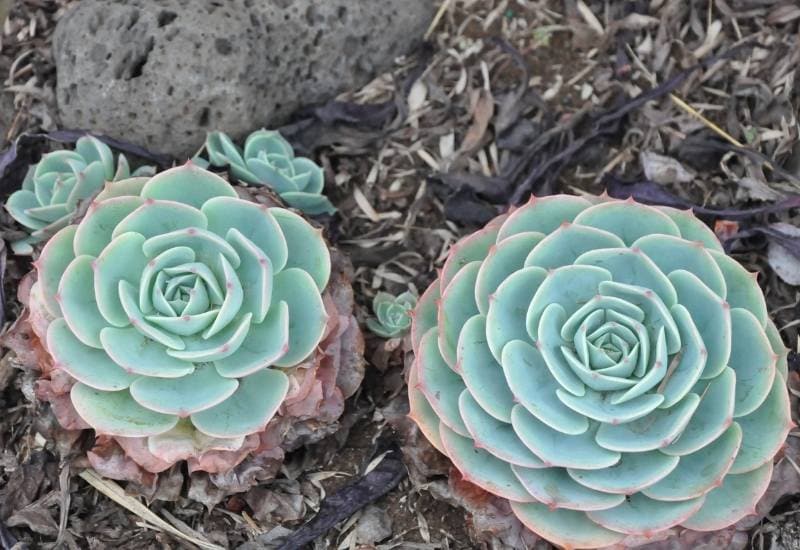
Hens and chicks is an evergreen succulent plant that really adapts well to groundcover purposes. It forms beautiful rosettes that grow low on the ground, covering it with foliage that can go from silver green to purple via many shades of green depending on the species.
It propagates spontaneously and fast, so, you can plant a few scattered specimens and it will soon fill in the gaps on its own.
The rosettes vary in size according to the species, reaching a maximum of one foot (30 cm) in very large ones like Sempervivum ‘Hart 8’.
While it is a succulent, it grows on rocky slopes high up in tall mountains like the Alps, and in fact, they will be not be bothered by snow and cold.
4: Ice Plant (Delosperma spp.)
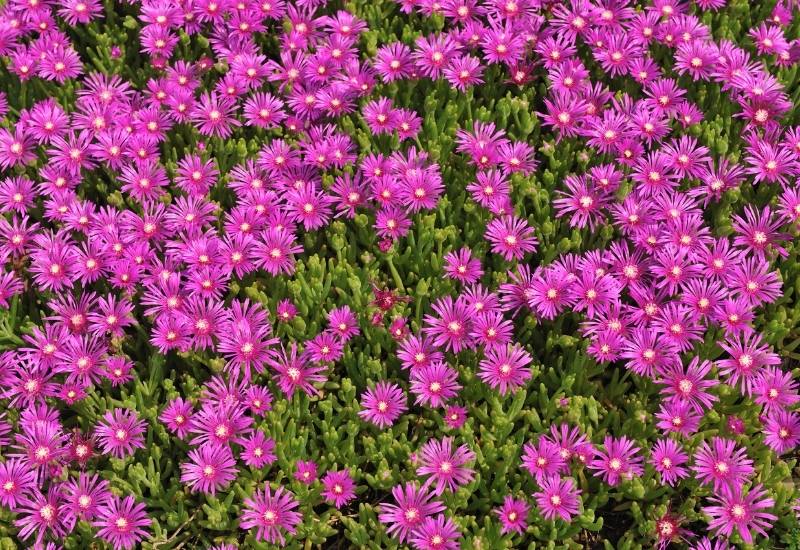
Here is another excellent succulent to use as evergreen groundcover. Ice plant is a perfect small carpeting plant which propagates very easily and it can fund its way even in small crannies and oddly shaped corners.
The leaves are thick and beautiful; they look a bit like tiny fingers or swollen needles.
The flowers though… They have the brightest colors, white, magenta, red, orange, purple or pink and they look like asters.
However they have a striking waxy quality which reflects the light very well. And they are so many… So many that you will hardly see the foliage underneath them!
5: Stonecrop (Sedum spp.)
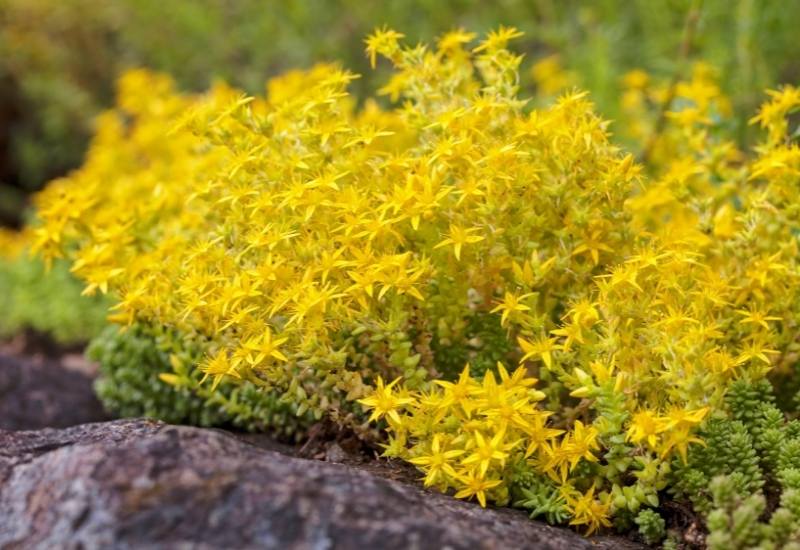
Stonecrop is a large genus of succulents that work really well as groundcover. They are evergreen, but the leaves can be green, blue, red, purple or yellow depending on the species, on the season and on the light.
There are also variegated varieties like the cream and green ‘Autumn Charm’ for example. These little plants propagate naturally and they offer a wide range of colors and personalities to cover bare ground. However, you can also use them in flower beds, containers and rick gardens.
The flowers come in racemes on top of stems that tower over the foliage, usually pink in color. This adds value to stonecrop as a garden and container plant.
Conifer (Like) Evergreen Groundcover Plants
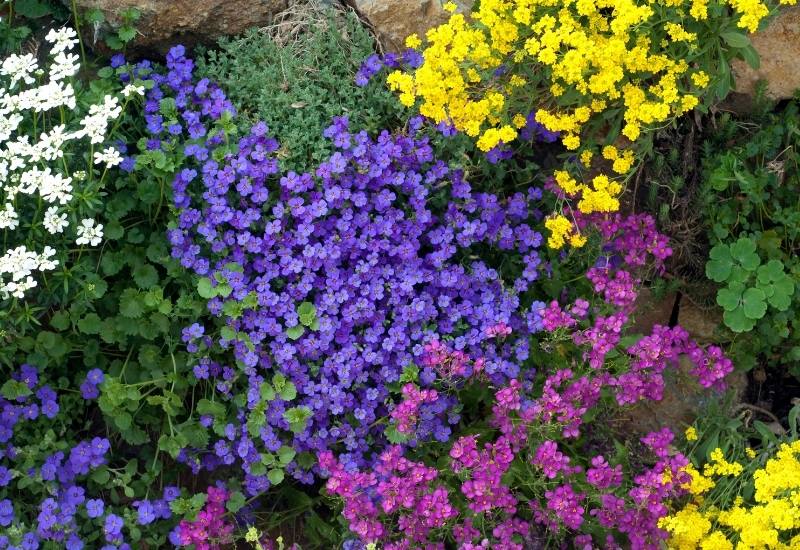
Conifers are famous for having foliage that stays on all year round. They are also very strong and long lasting plants, often quite cold hardy and very easy to grow.
They are ideal for gardens in temperate and cold regions and very popular in low maintenance urban and home gardens.
6: Juniper Leaved Thrift (Armeria juniperifolia)
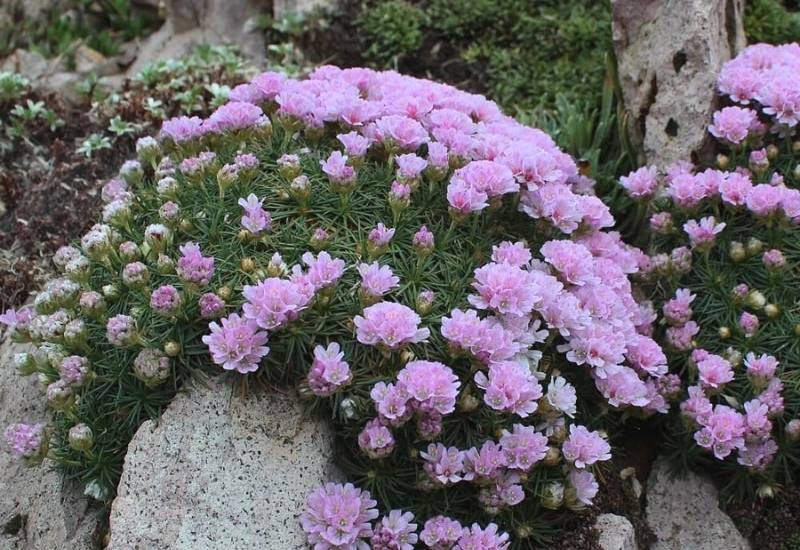
Juniper leaved thrift is an evergreen groundcover which offers the best of two worlds: conifers and flowering plants! In fact, it is not a juniper,
but an evergreen thrift with leaves that look like that of juniper. They are silver green and needle shaped, and they will cover your land all year round with the conifer look.
But conifers do not bloom, while thrifts do! And juniper leaved thrift is very generous! It will cover in beautiful,
bright magenta flowers that look a bit like asters. So, you bare patch of land can turn rich green all year round and then magenta from late spring.
7: Creeping Juniper (Juniperus horizonatlis ‘Blue Chip’)
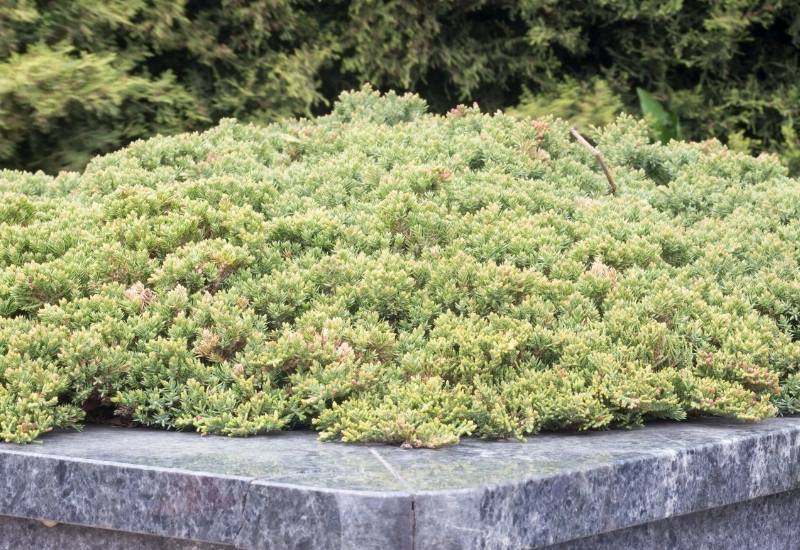
Creeping juniper is a classic when it comes to evergreen groundcover plants. It is in fact one of the protagonists of that post WWII
revolution in gardening which has seen low maintenance, often evergreen plants used for suburban gardens owners had little time to spend tending.
The ‘Blue Chip’ variety has all the beauty of the thick, richly textured and fragrant conifer foliage, but I have chosen it because it has a bluish green color.
So, it can give that extra “touch” of color and depth both as groundcover, but also in flower beds, gravel gardens and rock gardens.
8: Siberian Carpet Cypress (Microbiota decussata)
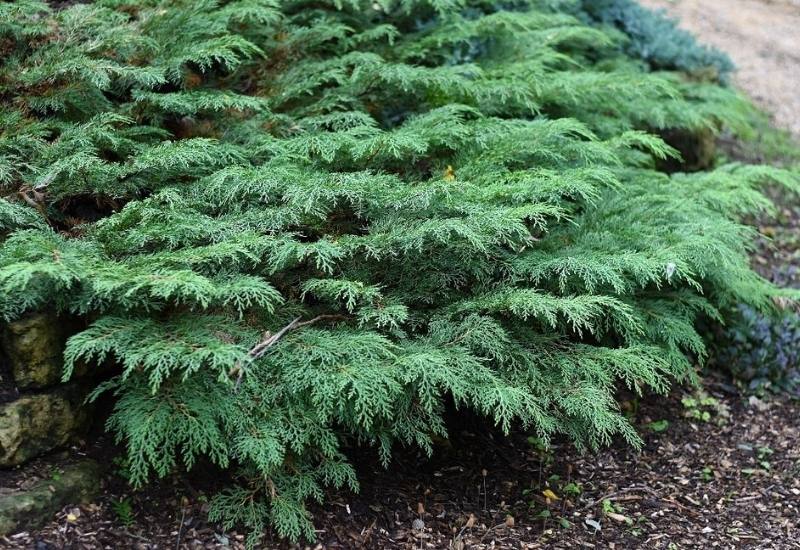
This evergreen shrub comes from Siberian mountains and it looks very much like a cypress. It is actually a conifer, but not a cypress and, being used to very cold temperatures,
it is ideal for severe winters. In the wind-swept Siberian mountains, instead of growing upwards, this species grows flat on the ground, forming thick carpets of beautiful rich green foliage.
Siberian carpet cypress is a very sturdy hardy and undemanding plant. It looks great against gravel or colored wood bark mulch. It will give you permanent and long term groundcover. One single plant can actually cover a large area.
9: Garden Juniper (Juniperus procumbens ‘Nana’)
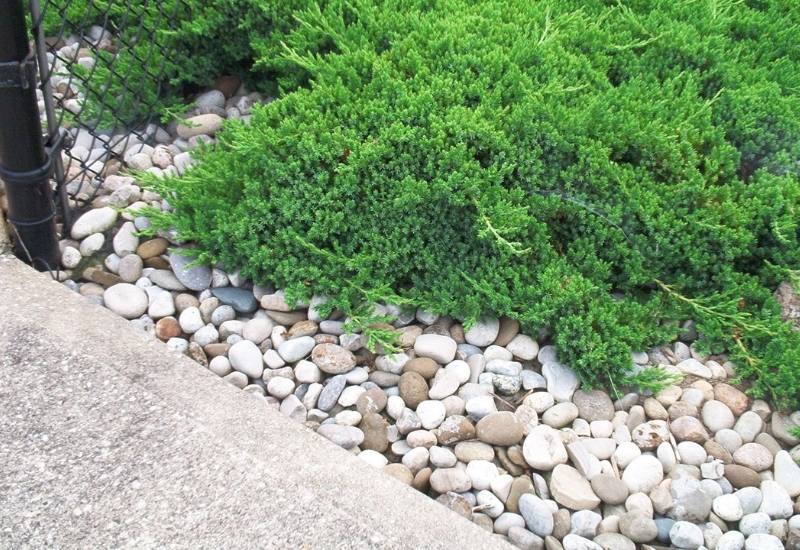
Garden juniper is another classic conifer used as evergreen groundcover, and winner of the Award of Garden Merit by the Royal Horticultural Society.
It has very beautiful thick green foliage that forms a wonderfully rich texture. In fact it looks like a very elaborate but delicate hand made carpet.
It is a plant that adapts well to formal and informal gardens, and it will look great in Asian looking gardens too.
As ground cover, a single plant can cover a wide area, but it doubles as an excellent gravel garden and urban garden plant, and it looks very much at ease in a rock garden too.
Evergreen Flowering Crawling Shrubs
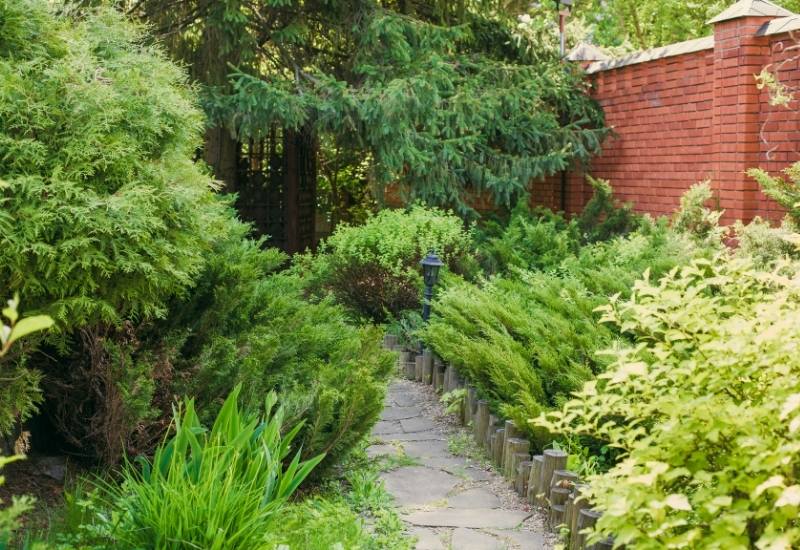
Some evergreen crawling shrubs also flower during the warm season. For this reason, they adapt very well to groundcover purposes like conifers.
But unlike conifers they also bloom, adding extra value to your garden. And in some cases, the blooms are followed by very attractive berries too.
10: Creeping Thyme (Thymus coccineus)
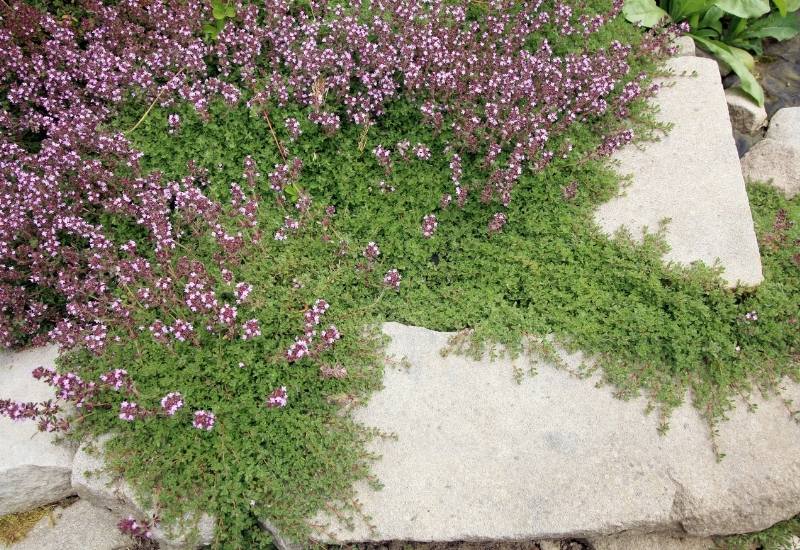
We could not miss creeping thyme among the best evergreen groundcover plants. It’s just fantastic…
It has a beautiful Mediterranean shrub look, with so many tiny elliptical leaves on very thin and woody branches… These are stout and healthy plants that will cover your soil with little or now maintenance.
But then you need to add the long and intense blooms, usually lavender, but magenta and other shades of purple or white are also possible.
These are massive events that last through the summer months and look like someone has dropped paint on your garden…
And then, of course, thyme is a striking herb with a unique flavor as well as great medicinal qualities.
So, guess… It is a worthy winner of the Award of Garden Merit by the Royal Horticultural Society.
11: Cotoneaster (Cotoneaster spp.)
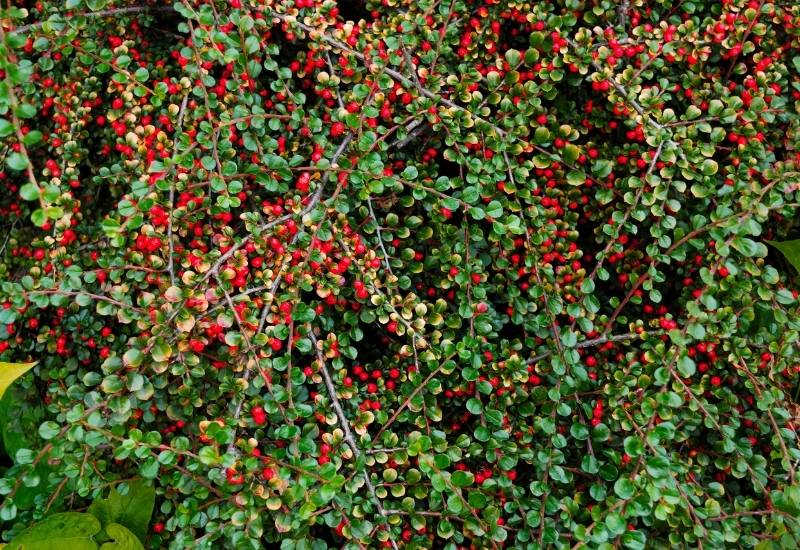
As evergreen groundcover cotoneaster offers thick foliage made up of tiny elliptical and glossy leaves.
These grow on the branches of what is in fact a low, almost creeping shrub. It is quite common in front gardens and urban gardens because you can cover a wide spot with a single, low maintenance plant and you get three effects for one plant.
The leaves, as you’d expect, stay on all year round, but they turn red in winter and then again green in spring. This effect is quite interesting to use in a garden.
But wait… In late spring to early summer it fills with many tiny but beautiful white flowers with very round petals.
A after that, the whole plant fills with bright ruby red berries that stay in till frost. Now I am sure you can see why this plant is gaining popularity?
12: Bearberry (Arctostaphylos uva-ursi)
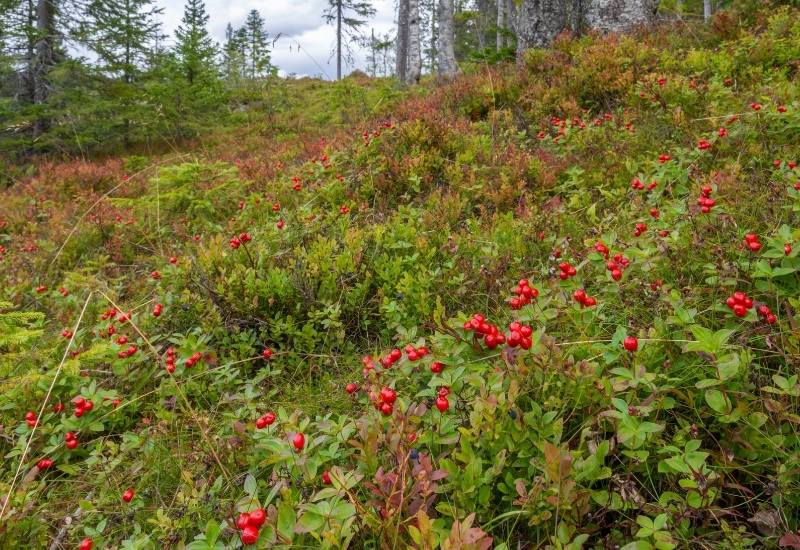
Let’s start our selection of evergreen ground cover plant with a real beauty: bearberry, or bear grapes.
The low, creeping plant has beautiful fleshy and glossy rounded green leaves, quite hard and stiff to the touch. They form a lovely texture on the ground, and their “holly looking” presence is quite decorative indeed.
In spring, it will also produce lovely bell shaped sugary flowers. These are white with lovely pink edges.
For this reason, bearberry is great as groundcover, but also in low flower beds, borders and especially rock gardens. It will keep green even in very cold places, like Canada.
Herbaceous Evergreen Groundcover Plants
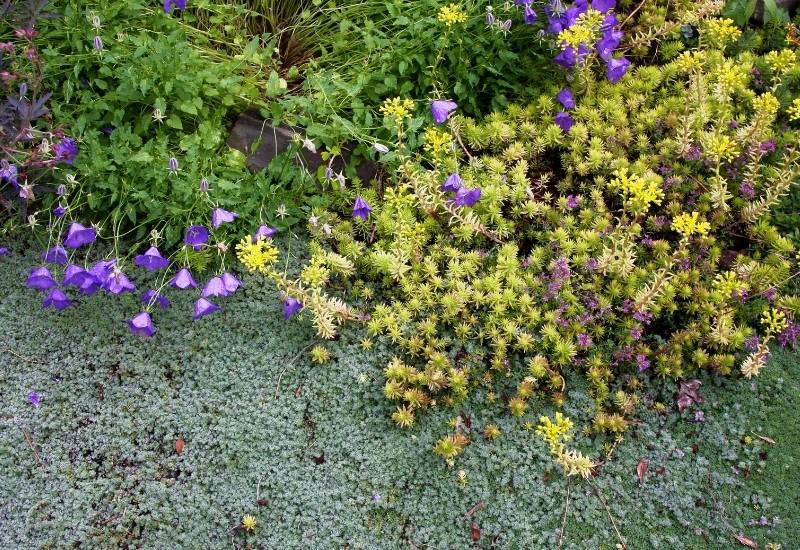
The classic herbaceous look of groundcover offers many plants for your garden: different leaf shapes, some like blades and some like hearts.
They also have many flowering varieties, even with exotic blooms. These are excellent for small but also large areas, which they can fill with green, but also many other colors.
13: Western Wild Winger (Asarum caudatum)
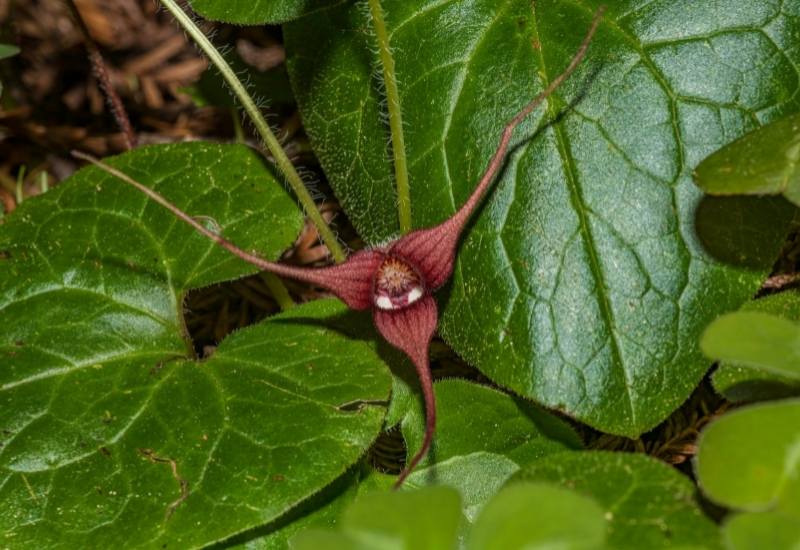
Western wild winger is fairly unknown evergreen groundcover plant – but a striking one. Ideal for warmer regions, as it is not cold hardy, this exotic looking plant has beautiful emerald green heart shaped leaves, a bit like those of cyclamens, but veined and very thick.
Like cyclamen it adapts to poorly lit places, like under trees and shrubs, or in that corner where the wall blocks the light all day long.
But wait… in late spring it will also bloom with very exotic looking, unusual flowers. These are burgundy purple and have three long petals that look a bit like strings, and the center is bell shaped with yellow parts inside! Really striking.
14: Wormwood (Artemisia schmidtiana ‘Silver Mound’)
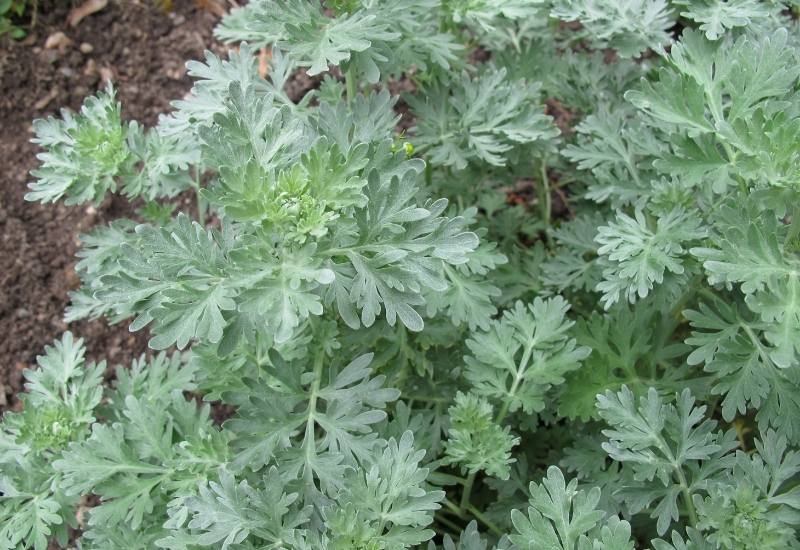
Wormwood is a semi-evergreen ground cover plant. This means that it will, be evergreen only if winters are not too cold. But it is so beautiful that it needs a mention and a little “bending of the rule”.
It is an Artemisia species, so, it has all the decorative and textural quality of the species, with partite leaves. These, however, are very thick in this species, forming a thick and soft looking carpet.
It naturally shapes itself into clumps that look like cushions. The foliage is silver green, so very attractive to the eye. Flowers are regular in spring, but small, yellow in color.
15: Silver Carpet (Dymondia margaretae)
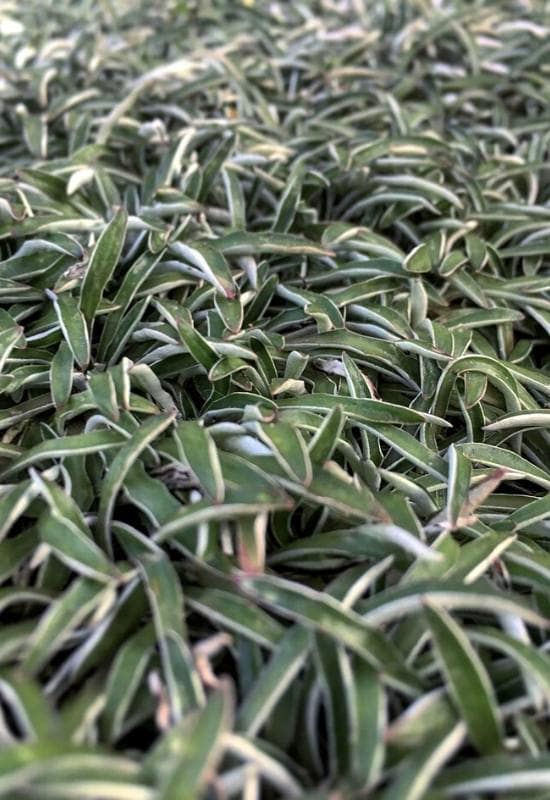
Silver carpet is an evergreen groundcover plant that offers you the “wild look” but all year round. It spreads to form long, thin and pointed leaves, silver green in color.
The leaves are thick bit they orient themselves in different direction, a bit like disheveled hair. In summer, you will also get yellow flowers that look a bit like petals.
This is an excellent plant for groundcover but also rock gardens and especially for xeric gardens (where you have little water), sandy soil and even coastal garden, as it tolerates salty climates. In fact, it comes from the wind swept coasts of South Africa.
16: Evergreen Sedge (Carex peduncolosa, Carex eburnea and Carex pensylvania)
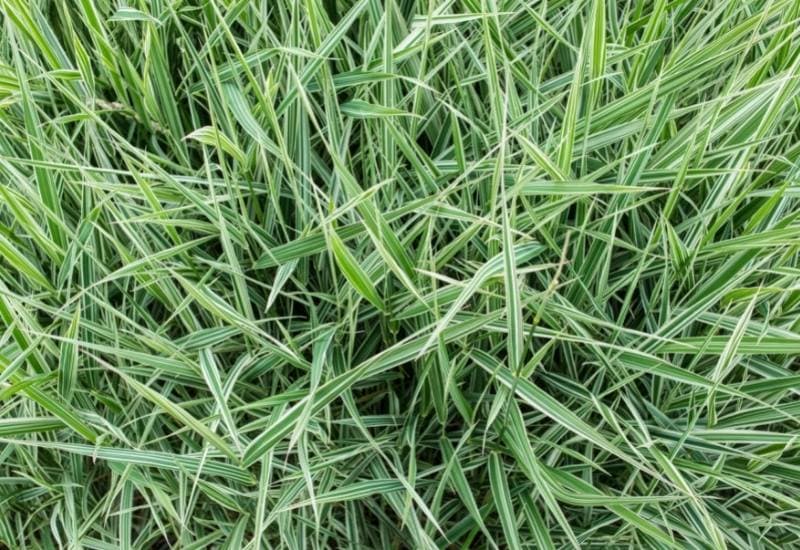
As groundcover, sedge will give you those elegant grass looking tufts. They are ideal for a wild prairie, mountain meadow or even part desert look.
Some sedges are semi-evergreen, like Japanese sedge (Carex ‘Ice Dance’), with very decorative blue and white leaves, others, like the three we suggest, are perennials.
They are native of North America, where they grow in open spaces and in the dappled light near trees.
They have a wilder look than many of their relatives, like brown sedge, blue sedge or ‘Variegata’ (semi-evergreen too). Still, like their relatives, they will still look good against gravel as well as used to cover ground.
17: Basket of Gold (Aurinia saxatilis)
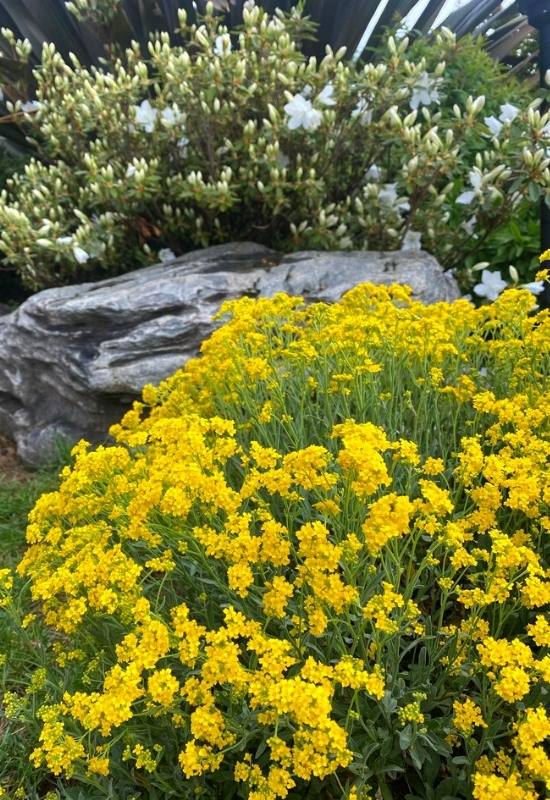
Basket of gold is a lesser known but striking evergreen you can use as ground cover. The foliage has a wonderful texture, like filigree with silver white leaves that also have a touch of light azure blue in them.
They form very thick but intricate little bushes that look like jewels, really. Not bad to cover that ugly spot of bare soil!
But while you will enjoy the shiny foliage also in winter, wait for spring… The plants will turn bright and vivid yellow with a bloom of tons of tiny but tightly packed flowers.
It is a very, very energetic and positive presence in a garden, a plant that will not just cover an unsightly spot… It will literally bring light into your garden all year round!
And the Royal Horticultural Society has recognized the value of this plant giving it a prestigious Award of Garden Merit.
18: Evergreen Candytuft (Iberis sempervirens)
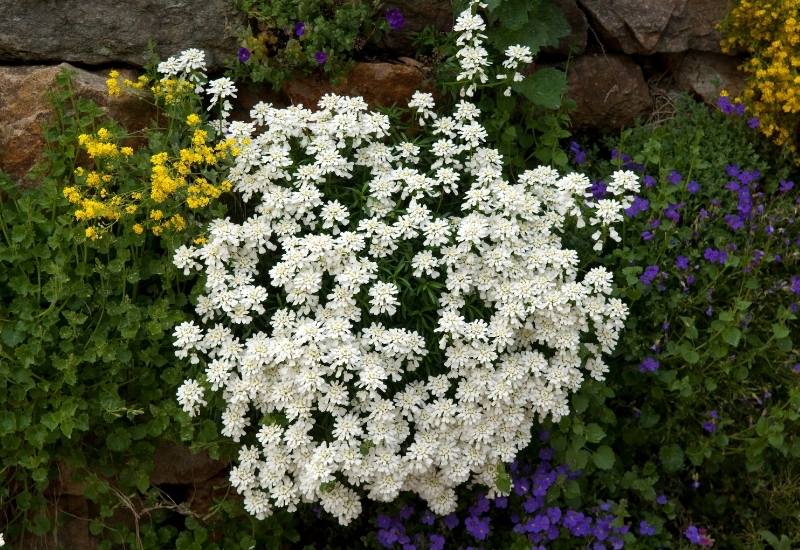
And we want to close our list of amazing evergreen groundcover plants with a lesser known beauty: evergreen candytuft.
It is a fairy tale looking little plant, with a candid look that will remind you of Snow White, weddings, sugary candies, snow….
Well, you got the “white theme”. In fact the flowers are very small, like snow flakes actually. But they come in thick round inflorescences.
And this plant top is very, very abundant indeed. Basically, you will get a sweet looking white coat if you grow this plant as groundcover.
The leaves are thick and light green and it will stay so all through winter. But you will not even see it when the plant is in bloom… In fact, it will literally look like its has snowed on it, in spring!
This is an excellent plant fir ground cover, but also for informal borders and flower beds. If you have a white garden, this may well be by far your best choice among all the evergreen ground cover plants we have met in this article.
Not Just a Warm Carpet
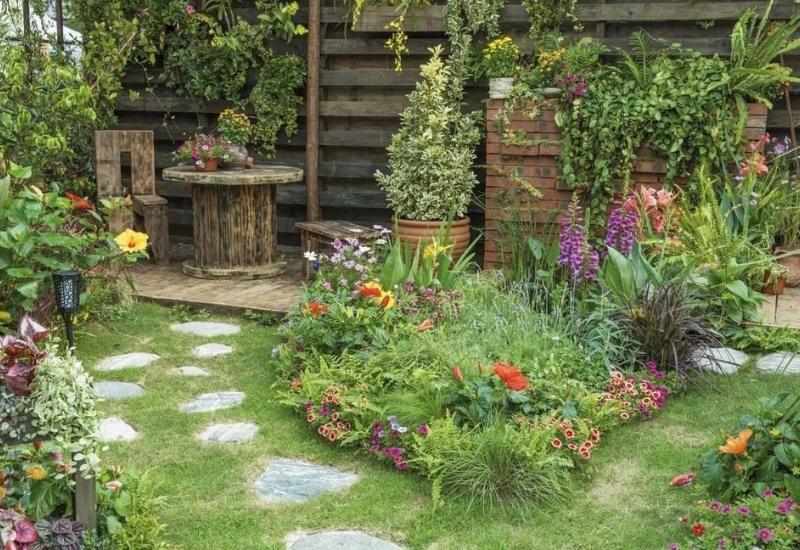
You see, evergreen ground cover plants keep the soil well protected from “the elements” (cold, wind and rain) during the winter months.
This makes them very useful plants for your garden. They keep all the tiny animals that work on your garden behind your back alive,
like the many insects that need shelter when the weather is bad. But they also keep the nutrients in the soil, so they don’t get washed away…
But now you must also agree with me that these plants have one thing in common: they are all beautiful!
And now you know that there are plants for all sorts of gardens, in warm and cold climates, for Sun and for shade, for formal and informal gardens, for all types of soil…
I trust you can find one (or some) that suit your need in this list…

Written By
Amber Noyes
Amber Noyes was born and raised in a suburban California town, San Mateo. She holds a master’s degree in horticulture from the University of California as well as a BS in Biology from the University of San Francisco. With experience working on an organic farm, water conservation research, farmers’ markets, and plant nursery, she understands what makes plants thrive and how we can better understand the connection between microclimate and plant health. When she’s not on the land, Amber loves informing people of new ideas/things related to gardening, especially organic gardening, houseplants, and growing plants in a small space.
